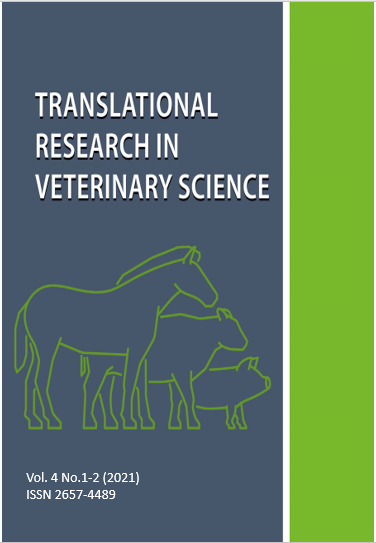AFRICAN SWINE FEVER IN POLAND AND EASTERN EUROPE. CURRENT EPIZOOTIC STATUS AND PERSPECTIVES FOR ITS ERADICATION.
DOI:
https://doi.org/10.12775/TRVS.2021.001Keywords
ASF, Pig, Infectious Disease, Pandemic, Public HealthAbstract
Animal production is of major economic importance in a number of European countries, including Poland. In terms of swine production, there are over 1.3 billions of swine worldwide. The EU is the second largest pork producer with over 186 millions of swine. In Poland, according to the data from EUROSTAT, in June 2020, the number of pigs exceeded 11.43 million, showing an increase of 6.0% compared to the same period in the previous year. The observed international fluctuation in the produced pigs’ number is mainly related to the lack of profit in production due to the occurrence of infectious diseases, with African Swine Fever (ASF) amongst them. ASF in Poland has been a major threat for pig production for the eight years. The main problems in ASF eradication in Poland are due to the high density of wild boar. Other factors, responsible for long-distance ASF spread are related to human-mediated activity and lack of awareness of pig producers. The observations from the eight years of ASF epizootic in Poland indicate that the disease could not have been effectively controlled in wild boar population and could only be restricted in domestic pig population following stringent biosecurity measures. The only solution for future sustainable pig production in Poland seems to be strict collaboration between pig producers, veterinary inspection, and hunters.
References
EUROSTAT. Pig farming in the European Union. European Commission. 2020. Retrieved from https://appsso.eurostat.ec.europa.eu/nui/show.do?dataset=apro_mt_lspig&lang=en. Accessed 26 August 2021.
FAO, Food and Agriculture Organization of the United Nations (FAO), World Organization for Animal Health (WHO), World Bank WB). Good practices for biosecurity in the pig sector – Issues and options in developing and transition countries. FAO Animal Production and Health Paper No. 169 2010, Rome.
Niemi JK. Impacts of African swine fever on pigmeat markets in Europe. Front. Vet. Sci.2020; 7, 634.
GVI General Veterinary Inspectorate (2020) African Swine Fever Reports in Poland. Retrieved from https://www.wetgiw.gov.pl/nadzor-weterynaryjny/asf-w-polsce. Accessed August 26, 2021.
Arias M, Jurado C, Gallardo C, Fernández-Pinero J, Sánchez-Vizcaíno J.M. (Gaps in African swine fever: Analysis and priority. Transbound. Emerg. Dis.2018; 65, 235-247.
Beltran-Alcrudo D, Falco J.R, Raizman E, Dietze K. Transboundary spread of pig diseases: the role of international trade and travel. BMC Vet. Res. 2019; 15, 64.
Costard S, Jones BA, Martínez-López B, Mur L, de la Torre A, Martínez M, Sánchez-Vizcaíno F, Sánchez-Vizcaíno JM, Pfeiffer DU, Wieland B. Introduction of African swine fever into the European Union through illegal importation of pork and pork products. PLoS One 2013; 8, e61104.
Pejsak Z, Niemczuk K, Frant M, Mazur N, Pomorska-Mól M, Ziętek-Barszcz A, Bocian Ł, Łyjak M, Borowska D, Woźniakowski G. Four years of African swine fever in Poland. New insights into epidemiology and prognosis of future disease spread. Pol. J. Vet. Sci. 2018; 21, 835-841.
Danzetta ML, Marenzoni ML, Lannetti S, Tizzani P, Calistri P, Feliziani F. African swine fever: Lessons to learn from past eradication experiences. A systematic review. Front. Vet. Sci. 2020; 7, 296.
Cwynar P, Stojkov J, Wlazlak K. African Swine Fever Status in Europe. Viruses 2019; 11, 310.
Cappai S, Rolesu S, Coccollone A, Laddomada A, Loi F. Evaluation of biological and socio-economic factors related to persistence of African swine fever in Sardinia. Prev. Vet. Med. 2018; 152, 1-11.
Bellini S, Rutili D, Guberti V. Preventive measures aimed at minimizing the risk of African swine fever virus spread in pig farming systems. Acta Vet. Scand. 2016; 58, 82.
Abrahantes JC, Gogin A, Richardson J, Gervelmeyer A. Epidemiological analyses on African swine fever in the Baltic countries and Poland. EFSA J. 2017; 15, 4732.
Blome S, Gabriel C, Beer M. Pathogenesis of African swine fever in domestic pigs and European wild boar. Virus Res. 2013; 173, 122-130
Gogin, A., Gerasimov, V., Malogolovkin, A., & Kolbasov, D. (2013). African swine fever in the North Caucasus region and the Russian Federation in years 2007–2012. Virus Research, 173, 198–203. doi: 10.1016/j.virusres.2012.12.007
Kolbasov D, Titov I, Tsybanov S, Gogin A, Malogolovkin A. African Swine Fever Virus, Siberia, Russia, 2017. Emerg. Infect. Dis. 2018;24, 796-798.
Walczak M, Żmudzki J, Mazur-Panasiuk N, Juszkiewicz M, Woźniakowski G. Analysis of the clinical course of experimental infection with highly pathogenic African swine fever strain, isolated from an outbreak in Poland. Aspects related to the disease suspicion at the farm level. Pathogens2020, 9, 237.
Frant M, Łyjak M, Bocian Ł, Barszcz A, Niemczuk K, Woźniakowski G. African swine fever virus (ASFV) in Poland: Prevalence in a wild boar population (2017-2018). Vet. Med.(Praha) 2020; 65, 143-158.
Mazur-Panasiuk N, Woźniakowski G. Natural inactivation of African swine fever virus in tissues: Influence of temperature and environmental conditions on virus survival. Vet. Microbiol. 2020,242, 108609.
Fila M, Woźniakowski G. African swine fever virus – The possible role of flies and other insects in virus transmission. J. Vet. Res. 2020;64, 1-7.
Contact adress: Professor Grzegorz Woźniakowski, Department of Diagnostics and Clinical Sciences, Faculty of Biological and Veterinary Sciences, Nicolaus Copernicus University in Toruń, e-mail: grzegorz.wozniakowski@umk.pl
Downloads
Published
How to Cite
Issue
Section
License
Copyright (c) 2025 Grzegorz Woźniakowski, Zygmunt Pejsak

This work is licensed under a Creative Commons Attribution-NoDerivatives 4.0 International License.
Title, logo and layout of TR in VS are reserved trademarks of TR in VR.
Stats
Number of views and downloads: 80
Number of citations: 0



